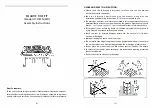
Step 5: Gas Piping and Connection
The gas piping must be installed in accordance with local
codes or, in the absence of local codes, in accordance with
the National Fuel Gas Code, ANSI Z223.1, latest edition.
The normal gas connection is 1/2" NPT, made at the left
side facing the unit. If a right side connection is desired, the
connecting pipe must be led at the rear of the fireplace to
terminate at the left hand side for connection to the
fireplace.
Piping should be tested for leaks prior to final wall
installation. Test for leaks using soap and water solution
after completing the connection. DO NOT USE OPEN
FLAME.
Step 6: Optional Procedure for Cold
Climate Installations
The insulation and sealing of the enclosure around the
fireplace is very important in cold climates. If the enclosure
is insulated and sealed properly, you can avoid future cold
air problems. The time taken to install the firebox correctly
is well worthwhile. The following steps are to reduce
potential cold air problems.
Insulation Of The Fireplace Enclosure
When in a chase or an outside wall, the fireplace enclosure
should be insulated like any other wall of your home.
Insulation should be installed on the outside wall(s) and the
wall above the fireplace.
Insulate To Seal Under The Fireplace
Insulating under the fireplace is beneficial for installations
on a concrete slab. The fireplace should be placed on
insulating board. It is important that a hard, rigid surface be
maintained, so do not use fiberglass insulation for this
purpose.
CAUTION:
WHEN INSTALLING A FIREPLACE IN AN
INSULATED ENCLOSURE, BE SURE TO MAINTAIN ALL
MARKED AIR SPACES.
Seal Seams
Seal the seams of the fireplace where the outer wall meets
the bottom pan and the front face. Also seal between the
fireplace and finishing materials. Use high temperature
caulk. See figure 5 for details of sealing spaces between
Figure 5
Figure 4
Figure 6B
42"
5"
Figure 6A
Figure 6C
Figure 6D
5
ADCH39;
ADCH45);




























